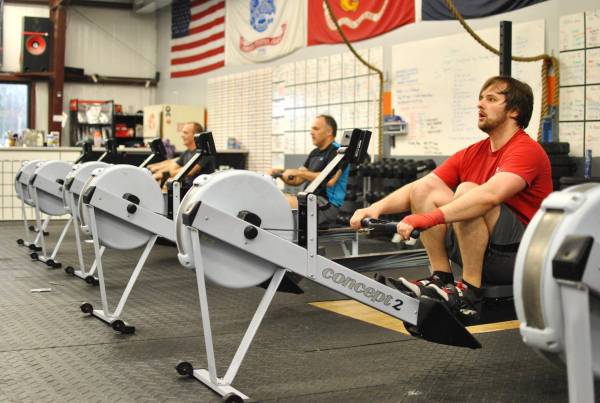Click Here to Start Your Free Rowing Program
Rowing is one of the oldest sports in the United States. A sport that used to be synonymous with only the elite, private-school culture of the East Coast is now the new and hot fitness addiction.
While the sport itself is experiencing incredible growth, the use of the indoor rower (erg, ergometer, or rowing machine) has been a driving force for the resurgence in popularity. The rowing machine has officially moved past its reputation of being the dust-collecting, odd-shaped apparatus in the corner of the gym, to being a staple in every fitness club.
“Rowing is the ultimate full-body workout. Legs, glutes, core, shoulders, arms, you name it – you work it in a rowing session.”
With the explosion of CrossFit and the use of the indoor rower in its workouts, and with more people today looking for a complete full-body workout, rowing is becoming cool and common again. Here’s how you can benefit from rowing and why you should try our free twelve-week training program.
The two of us competing in the 2013 World Rowing Cup in Lucerne
Why Rowing?
Rowing is the ultimate full-body workout. Legs, glutes, core, shoulders, arms, you name it – you work it in a rowing session. The indoor rower is not a fancy, high-tech machine. There is no television monitor or place to set your magazine. When you sit on the seat and pick up the handlebar, it demands hard work. But it will reward you with success.
READ: The 17 Commandments of Rowing – My Journey From Hate to Happiness
Whether you are a CrossFitter, want to pick up a new sport, or are just looking to get into better shape, rowing will help you achieve your fitness goals. The bodies of elite rowers are fine-tuned, chiseled specimens thanks to the thousands of hours spent training in a boat or on the indoor rower.
What You’ll Get From These Workouts
Our six-day-per-week training program is designed for the beginner-to-intermediate rower who is in moderate-to-advanced physical condition. Most of the workouts are sixty minutes or longer with varied intensities.
The goals of this particular training plan are to:
- Introduce you to some of the types of rowing workouts
- Build a solid fitness base, increasing both your strength and stamina
- Improve your overall 500-meter to 2,000-meter ergometer scores
Most of the workouts in this plan will be done on the erg (rowing machine). If you are lucky enough to be able to row on water, we absolutely encourage that!
“Rowing is a power endurance sport. You need to work both your anaerobic and aerobic systems to maximize your potential.”
You’ll notice this training plan is coded by varying degrees of intensity. Rowing is a power endurance sport. You need to work both your anaerobic and aerobic systems to maximize your potential. For this reason, some workouts in the plan are geared toward your anaerobic system, while others focus on the aerobic. Don’t skip around or pick and choose workouts!
RELATED: Isometric Exercises Just Prior to Rowing Improve Sprint Times
The variety and order of the workouts are important for recovery and to achieve your maximum potential on the test days. Think of the training plan as constructing a pyramid – if you don’t put the work into building a solid base, you’ll never reach the top.

Pay attention to your heart rate and/or perceived effort daily to adequately follow the training plan. This is a key element of understanding and properly training for rowing. At the elite level, exact training zones are determined by lactate testing, but the prescribed heart rate/perceived exertion zones in this plan will give you a solid framework.
Track your workouts in a journal. Keep record of each workout, noting your splits and heart rate or perceived effort. A workout journal will help you observe trends in your improvement, identify where your weaknesses and strengths may be, and effectively approach those big testing workouts.
READ:Coaching Tip: The Importance of Journaling
Keeping a journal can also be a way of preventing injury, illness, or overtraining. Take note of how you’re feeling, sleep patterns, and nutrition on a daily basis. If you do become sick, too run down, or need to take a day off, then take one! An important part of training is learning to listen to your body and knowing when to rest. Once you feel better, reenter the training cycle with at least one easier day before jumping into a higher intensity workout.
“Keeping a journal can also be a way of preventing injury, illness, or overtraining. Take note of how you’re feeling, sleep patterns, and nutrition on a daily basis.”
While this training plan only calls for one workout per day, the elite rower will train two to three times per day, six to seven days per week, with strength training being an important element. If you wish to incorporate a strength-training regimen with this plan, we suggest lifting two or three days a week on Monday, Wednesday, and/or Saturday. Ideally the lifts would be done after the rowing workout.
Tips for Beginners
For the novice, the rowing machine can be an intimidating beast. For the elite rower, it still stirs up those anxious feelings that come from knowing you’re going to be pushed to your limit. The rowing machine keeps you honest by providing you with feedback on every stroke, showing you how hard you are working through the split and watt read-out on the monitor.
YOU’RE NOT ALONE: Everybody Hates the Ergometer
The setup of the erg is actually quite simple, and once you get the hang of all of those buttons and screen options, you’ll be good-to-go. Setting the drag factor (sometimes referred to as the damper setting) is the most important step in making sure the erg is properly set up. The damper is the lever on the right side of the flywheel, which controls how much air flows into the cage. On most ergs, the damper can be set at a value of 1-10 (1 = lowest drag factor and 10 = highest drag factor).

Think of the damper setting or drag factor as being similar to a bicycle gearing. It affects how rowing feels, but does not directly affect the resistance. Many people automatically think that a higher damper setting will equate to a higher intensity level or resistance. Truthfully, the intensity of your workout is controlled by how hard you work.
“The rowing machine keeps you honest by providing you with feedback on every stroke, showing you how hard you are working through the split and watt read-out on the monitor.”
If you are healthy and in good condition, we recommend setting a drag factor in the range of 110-120. Every erg is a little different (differences in temperature, elevation, and dust on the flywheel can all affect drag factor), but on most machines a 110-120 drag factor will usually fall somewhere along the level 4-6 on the damper setting.
How to Set Your Drag Factor:
- Go to “Menu.”
- Select “More Options.”
- Select “Drag Factor.”
- Start rowing and a number will appear on the screen. Adjust the damper lever up or down until the desired drag factor is achieved.
Now you are ready to set up the workout. It will be tough, you will get tired, but you’ll also get fit and fast. Just keep rowing!
Click Here to Start Your Free Rowing Program
Photo 2 courtesy of Shutterstock.
Photo 3 courtesy of CrossFit Impulse.






